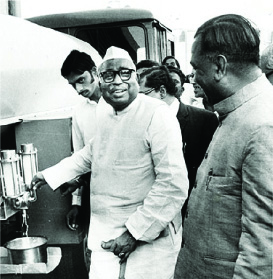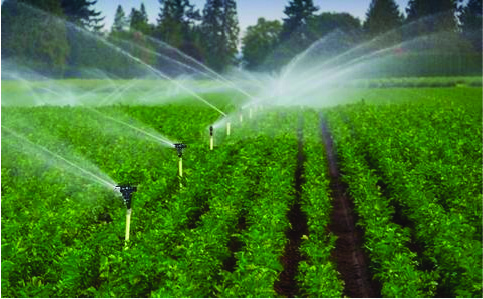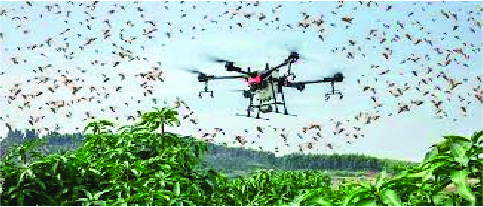From the good old days of sustenance farming, India has taken a quantum leap to industrial-scale thanks to modernisation and policies conducive to its growth. With the country now boasting of food security and turning out to be a major exporter, the Green Revolution is well and truly here to stay, says Vanshika Arora.
In the last few decades, the world has witnessed a phenomenal increase in agricultural production and output. Several nations, including India, have moved from sustenance farming to industrial-scale farming. Science, technology and agricultural reforms by way of policy making and legislation have helped support the expansion and modernisation of agriculture.
The exponential increase in production can be primarily attributed to improvement in agricultural practices, extensive cultivation, inclusion of more land area into agriculture, etc. The collective initiatives have led to improved productivity of land and better returns on investment in labour-intensive activities.
Although bringing more land area under cultivation is not feasible in most countries, it’s a crucial step towards increasing agricultural production. One of the biggest drivers in increasing agricultural production has been the modernisation of agriculture. Prosperous agriculture is an important variable in the equation deciding the economic development of a nation.
Modernisation of agricultural practices
Generally, modernisation involves upgrading agricultural techniques and improving equipment used in agricultural activities. These include using improved quality of seeds, bringing in modern machinery on the farm such as harvesters, threshers, tractors, etc., use of chemical fertilisers and pesticides and improved irrigation methods ensuring the right amount of water for crops.
In India, like most developing economies around the world, agriculture is a predominant economic activity. Modernisation of agriculture has taken place in phases in the country. In the first two decades after independence, there was a significant increase in the net area brought under cultivation through a continuous process of land reclamation and land improvements. In this phase, the nation witnessed a slight improvement in land productivity and labour productivity.
In the next two decades, there was a widespread modernisation of agriculture and increased capital investments. In the years that followed, agriculture development in India saw significant improvements in the productivity of land, labour and capital. This period also saw an improvement in the ‘utilisation of basic infrastructure and growth potential created during the earlier phase of modernisation’ in agriculture in India.
Agricultural revolutions ensured food security
India has seen several agriculture revolutions since Independence. An agriculture revolution is a transformation of traditional agricultural system or an unprecedented increase in agricultural production. These revolutions have helped in the exponential growth of agriculture in the country and changed the ways of production, increased production rate, created economic opportunities and ensured food and nutrition security in a young nation.
Modernisation has been a key catalyst in agricultural revolutions. In India, one of the most important agriculture revolutions has been the Green Revolution. Initiated in the 1960s, the green revolution was marked by the introduction of high-yielding varieties of rice and wheat to increase food production. The primary goal of this exercise was to address the hunger and poverty problems in the country. Post-Green Revolution, due to government initiatives, the production of wheat and rice doubled.

Green Revolution tackled malnourishment
Today India is self-sufficient in food production. In fact, it is a major exporter of several agricultural products. However, post-independence, in the 1960s the country was facing the imminent risk of a famine. At the time, the Green Revolution helped in increasing food production especially in Punjab, Haryana and Uttar Pradesh and helped in tackling malnourishment in the country.
Through adoption of modern technology and agricultural methods, the Green Revolution led by agriculture scientist M S Swaminathan leveraged agricultural research and technology to increase production. The Green Revolution in the country was part of the larger green revolution in the world initiated by Norman Borlaug.
During the Green Revolution, several changes were made in agricultural practices. These include modern irrigation infrastructure and techniques including sprinklers or drip irrigation systems; supply of agriculture credit; use of pesticides, herbicides, insecticides and chemical fertilisers; implementing land reforms; improving rural infrastructure; consolidating land holdings; use of advanced machinery such as tractors, harvesters, threshers, etc.
Other agricultural revolutions
The Golden Revolution that occurred in the 1990s made India a world leader in the production of fruits such as bananas, mangoes, etc. and in the process provided sustainable livelihood opportunities to the farmers.
Through the efforts of Verghese Kurien, the Father of the White Revolution in India, India became the world’s largest milk producer. Operation Flood also made dairy farming India’s largest self-sustaining industry. Launched on 13 January 1970, the operation was the world’s largest dairy development programme and a landmark project of India’s National Dairy Development Board (NDDB) that transformed India from a ‘milk-deficient nation into the world’s largest milk producer, surpassing the United States of America in 1998.’

The objectives of Operation Flood included increase in milk production, supplementing rural incomes, fair prices for consumers and increasing income of farmers, reducing poverty and ensuring a steady milk supply.
The Yellow Revolution made India self-sufficient and net exporter of oilseeds. A record 25 million tonnes of oilseeds were produced from the annual oilseed crop during the early nineties.
Role of Government in modernisation
For any improvement in the agriculture sector, involvement of government is of paramount importance. The Indian government has played a crucial role in changing the face of agriculture in the country, facilitating modernisation and achieving food security.
These mainly include direct intervention in the market mechanism through price support and procurement policy and subsidisation of major agricultural inputs. In this regard, every season, the government announces the ‘procurement or minimum support price for each season for each crop and also arranges for the corresponding procurement or price support operations through public, cooperative and other state designated agencies.’
Such policies have played a crucial role in protecting the farmers from market uncertainties. Also, these supportive policies have encouraged the adoption of high yielding varieties of grains that has, in turn, expedited the process of modernisation.
One of the largest producers of food grains in the world, India has seen a significant boost in agricultural reforms in the last decade. Agricultural policies are increasingly becoming pro-farmers and the government aims to increase farmers’ income.
Special initiatives help farmers
Among the several plans, policies and initiatives, the government is working in the following areas – agriculture productivity, soil health cards, crop insurance, irrigation, total mechanisation, technology, animal husbandry and allied activities.
According to the Consortium of Indian Farmers Associations (CIFA) which is India’s top professional farmer’s organisation engaged in effective policy level interventions on behalf of farmers from all over India, ‘in order to double farmers income, the government needs to implement a consistent export/import policy and proactive market intervention to attain fair prices for agricultural produce.’
Precision farming is helping farmers reduce stubble in the fields. Also, the government has set aside USD 85 million for farm mechanisation in 2019-20, along with USD 1.7 billion to support over 90 million farmers under the Pradhan Mantri Kisan Samman Nidhi scheme (PM-KISAN). Drone and robotics are also helping farmers in a big way to chalk out precise solutions for agricultural problems.
Farmers of Andhra Pradesh, Telangana and Tamil Nadu are implementing precision agricultural methods that are helping them increase crop yield significantly. According to industry experts, adoption of these methods has increased the revenue by 35 per cent to 60 per cent per acre in some cases.
As Indian agriculture adopts new technologies such as agri drones, there is tremendous potential for technology market and supply. There is need for the government, academia, research institutions and the industry to work closely to ensure modernisation is implemented in a sustainable manner.

